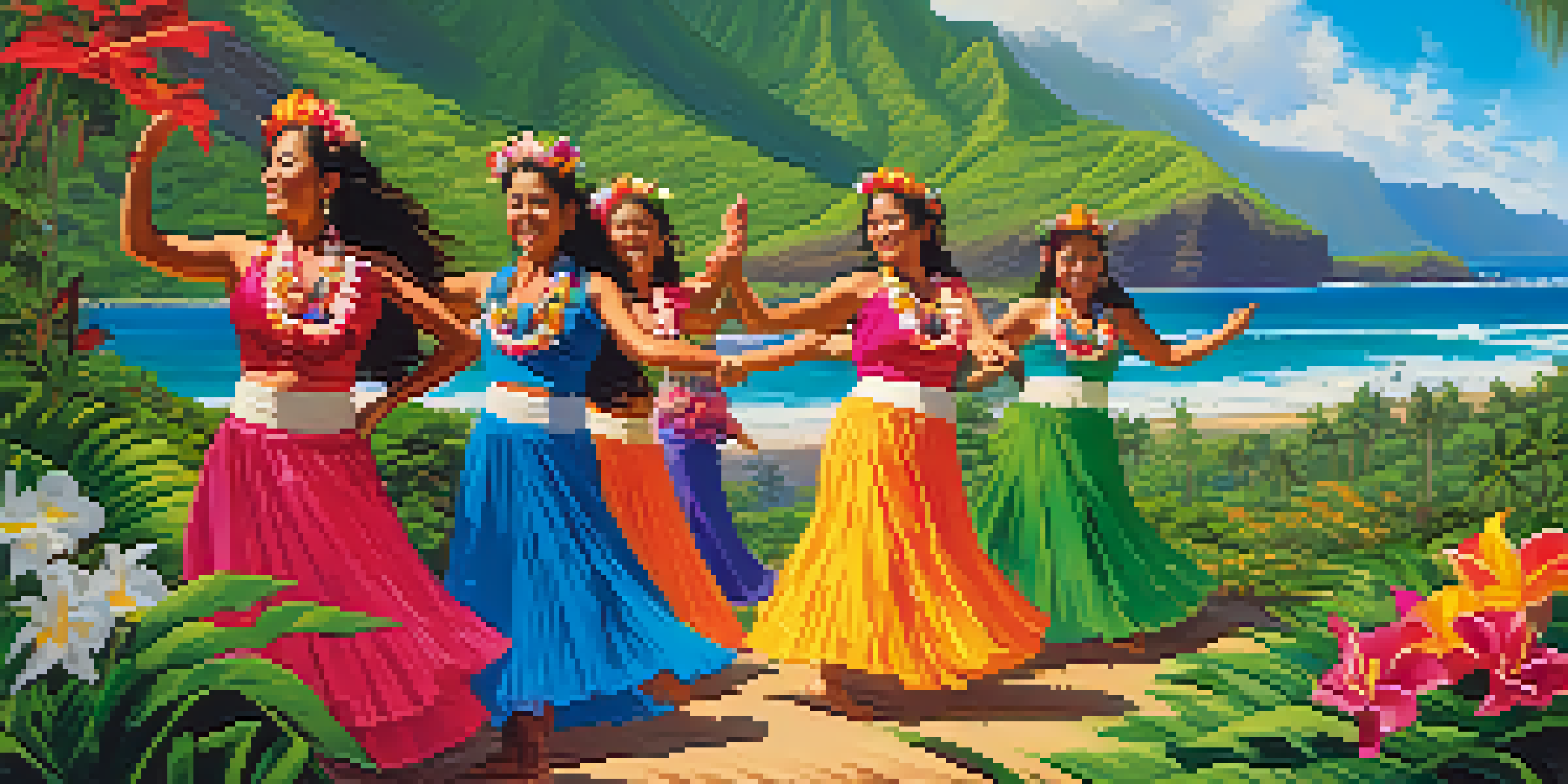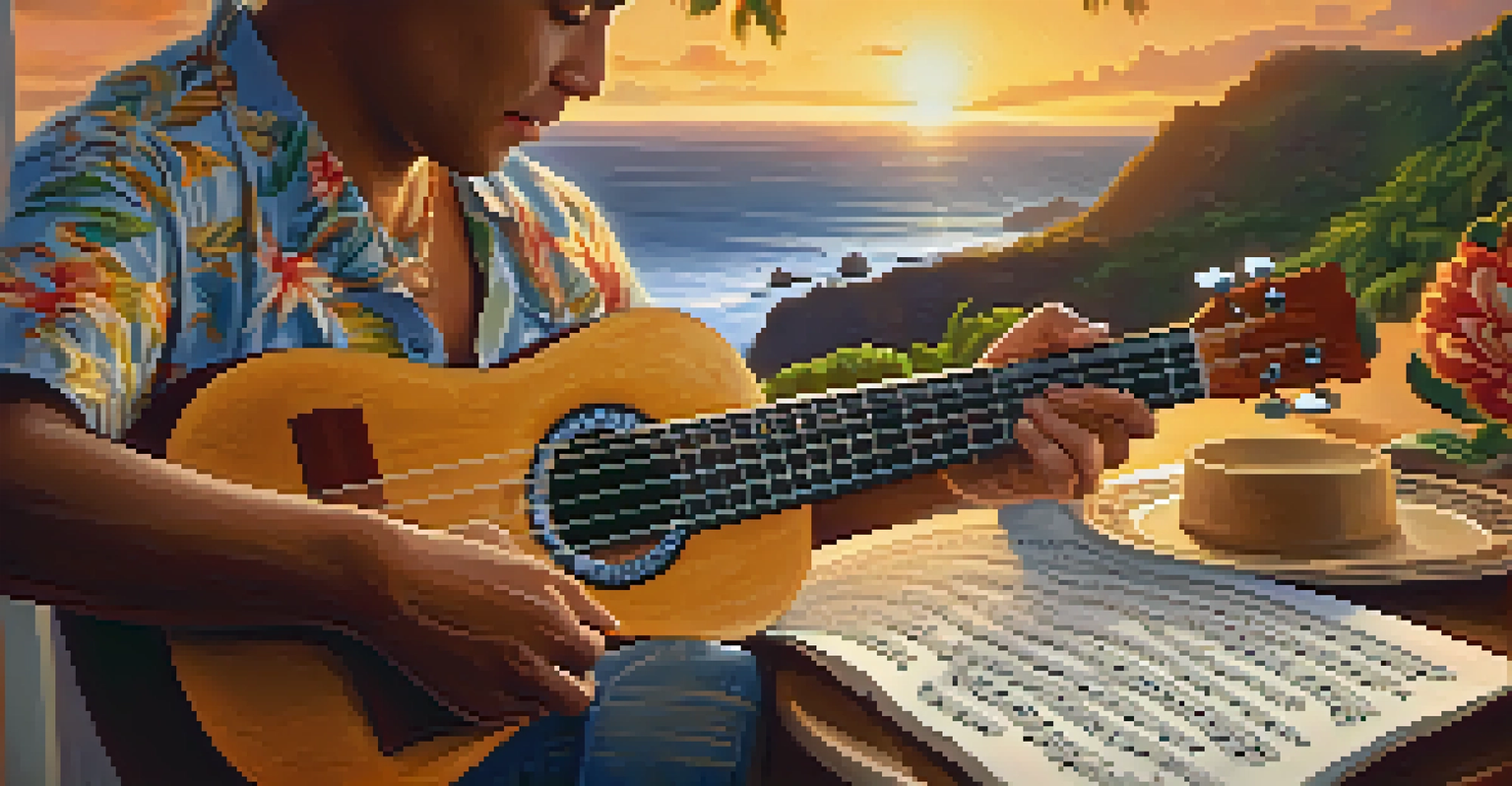The Influence of Hawaiian Language on Contemporary Music and Arts

Hawaiian Language: A Rich Cultural Heritage
The Hawaiian language, or 'Ōlelo Hawai'i, is more than just a means of communication; it embodies the rich cultural heritage of the islands. With roots that trace back to Polynesian voyagers, this language carries stories, traditions, and values that resonate deeply within Hawaiian culture. As artists and musicians tap into this heritage, they weave the language's lyrical beauty into their works, creating a bridge between past and present.
The Hawaiian language is the language of the land, and its words carry the essence of our culture and identity.
When you hear Hawaiian words sung in songs or spoken in performances, they evoke a sense of place and identity. For instance, phrases like 'Aloha' and 'Mahalo' are not just greetings but encapsulate the spirit of love and gratitude that permeates Hawaiian culture. This emotional depth enriches contemporary music and arts, allowing audiences to connect with the content on a personal level.
By incorporating 'Ōlelo Hawai'i, artists are also participating in the revitalization of the language itself. As the younger generations embrace their heritage, this revitalization becomes a powerful statement about cultural pride and resilience, ensuring that the language continues to thrive in modern expressions.
The Role of Hawaiian Language in Modern Music
Contemporary Hawaiian music has seen a significant resurgence, with artists blending traditional sounds with modern genres. Musicians like Israel Kamakawiwo'ole have popularized the use of Hawaiian language in their songs, making it accessible to a global audience. His rendition of 'Somewhere Over the Rainbow' showcases the beauty of 'Ōlelo Hawai'i, illustrating how language can elevate music to new emotional heights.

In addition to traditional artists, many contemporary musicians are experimenting with genres like reggae, hip-hop, and pop, often infusing Hawaiian lyrics into their work. These cross-genre collaborations not only broaden the appeal of Hawaiian music but also celebrate the richness of the language. This fusion creates a unique sound that resonates with listeners from diverse backgrounds.
Hawaiian Language Enriches Arts
The Hawaiian language, 'Ōlelo Hawai'i, deeply influences contemporary music and visual arts, allowing artists to connect with their cultural heritage.
Moreover, the impact of Hawaiian language in music extends beyond the islands. International artists are increasingly incorporating Hawaiian phrases into their songs, recognizing the cultural significance and beauty of the language. This trend highlights how language can transcend boundaries, fostering a deeper appreciation for Hawaiian culture worldwide.
Visual Arts and Hawaiian Language: A Harmonious Blend
The influence of Hawaiian language extends into the realm of visual arts, where artists often incorporate Hawaiian words and phrases into their creations. This practice not only beautifies the artwork but also serves as a means of storytelling, allowing viewers to engage with the piece on a deeper level. Each word carries meaning and context, enriching the overall experience of the art.
Language is the road map of a culture. It tells you where its people come from and where they are going.
For example, local artists might use 'Ōlelo Hawai'i in murals or paintings to convey messages of community, identity, or environmental stewardship. By doing so, they invite the audience to reflect on the significance of the language and its connection to Hawaiian identity. This interplay between language and visual expression fosters a deeper understanding of the culture.
Additionally, art exhibitions often feature works that celebrate the Hawaiian language, showcasing the talents of artists dedicated to preserving and promoting their heritage. Such initiatives not only elevate the status of Hawaiian language in the arts but also inspire future generations to explore and embrace their cultural roots.
The Impact of Hawaiian Language on Dance and Performance
Dance and performance are integral components of Hawaiian culture, and the use of Hawaiian language plays a crucial role in these art forms. Hula, for instance, is a traditional dance that conveys stories and emotions through movements, often accompanied by chants or songs in 'Ōlelo Hawai'i. This connection between language and movement creates a powerful narrative that captivates audiences.
Performers use Hawaiian language to convey the essence of their dances, allowing the audience to feel the story being told. The poetic beauty of the language enhances the emotional depth of the performance, making it a multi-sensory experience. Through hula, practitioners not only celebrate their heritage but also educate others about the significance of their culture.
Revitalization Through Education
Educational programs that integrate Hawaiian language with the arts are essential for nurturing a new generation passionate about preserving their cultural roots.
Moreover, contemporary dance companies often incorporate Hawaiian language into their choreography, further bridging traditional and modern practices. By doing so, they ensure that the language remains a living part of Hawaiian culture, continually evolving while honoring its roots.
Educational Programs Promoting Hawaiian Language in Arts
In recent years, educational programs aimed at promoting the Hawaiian language through arts have gained traction. These initiatives often involve workshops, performances, and collaborative projects that engage students in learning 'Ōlelo Hawai'i. Through hands-on experiences in music, dance, and visual arts, participants develop a deeper appreciation for their cultural heritage.
For instance, schools may host hula classes or music workshops that emphasize the importance of Hawaiian language. By integrating language learning with artistic expression, students gain a holistic understanding of their culture. This approach not only fosters language proficiency but also encourages creativity and self-expression.
Such programs are instrumental in nurturing a new generation of artists who are passionate about preserving the Hawaiian language. As they explore their cultural roots through various art forms, they contribute to the ongoing revitalization of 'Ōlelo Hawai'i, ensuring its relevance in contemporary society.
The Global Influence of Hawaiian Language in Arts
Hawaiian language's influence is not limited to the islands; it has made its mark on the global arts scene as well. Artists worldwide are recognizing the cultural wealth embedded in 'Ōlelo Hawai'i, often incorporating its phrases and concepts into their works. This trend highlights the universal appeal of the language and its ability to resonate with people from various backgrounds.
For example, international musicians may draw inspiration from Hawaiian melodies and lyrics, creating songs that celebrate the beauty of the islands. This cross-cultural exchange enriches the global music landscape, fostering connections between diverse communities. It also encourages a greater appreciation for Hawaiian culture beyond its geographical boundaries.
Global Impact of Hawaiian Culture
The influence of Hawaiian language extends beyond the islands, inspiring artists worldwide and promoting a greater appreciation for Hawaiian culture.
Moreover, art exhibitions featuring Hawaiian themes or language have gained popularity in various countries. These events showcase the depth and richness of Hawaiian culture, inviting audiences to engage with its artistic expressions. By sharing their heritage on a global stage, Hawaiian artists contribute to a broader understanding of cultural diversity and artistic innovation.
Preserving Hawaiian Language Through Contemporary Arts
As contemporary music and arts continue to evolve, the preservation of Hawaiian language remains a priority for many artists. By infusing their works with 'Ōlelo Hawai'i, they create a vibrant tapestry that honors their heritage while appealing to modern audiences. This commitment to preservation ensures that the language remains relevant and accessible.
Furthermore, initiatives aimed at documenting and promoting Hawaiian language in arts play a crucial role in its preservation. Organizations and community groups often collaborate with artists to create resources that celebrate the language, from songbooks to art catalogs. These efforts help bridge the gap between generations, fostering a sense of continuity in cultural practices.

Ultimately, the influence of Hawaiian language on contemporary music and arts serves as a testament to the resilience of Hawaiian culture. As artists and communities come together to celebrate their heritage, they not only preserve the language but also inspire others to engage with and embrace the beauty of 'Ōlelo Hawai'i.